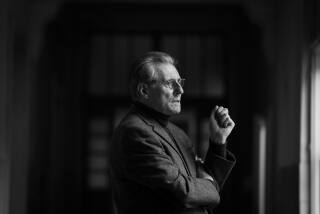MOVIE REVIEW : NOT A SPECK OF ARDOR IN ‘DANCING’
- Share via
Surprise is an element as tidily eliminated from “Dancing in the Dark” (at the Westside Pavilion) as dust is from Edna Cormick’s compulsive, sacrificial life. From the first affectless moments with Edna (Martha Henry) in a psychiatric hospital, we have a pretty good idea of the enormity of the event that brought her there.
It remains for us to go, in perfectly arranged flashback, to survey Edna’s past 20 years, as she re-creates them for her carefully probing doctor: her identity, formed completely as the wife of Harry Cormick (Neil Monro), an unexceptional, ambitious, not unaffectionate Ontario executive whom we glimpse occasionally from around the morning newspaper or pontificating at the dinner table.
We see the frenzy of her eight-hour days, spent with the ardor “of a nun dredging for salvation,” as she tries tirelessly to achieve perfection, banishing dust motes, smudges and lint from the home that is “her bomb shelter” from the world. We see her picture-perfect dinners, her skill as a listener (certainly not as a conversationalist), her unending gratitude to Harry for giving her life structure and meaning. (Not children; the question seems never to have come up.)
The crushing content of these days, described in Edna’s flat, unquestioning voice and in a kind of feminist-didactic literary style, is deliberately matched by director Leon Marr, who also adapted the screenplay from Joan Barfoot’s novel. In precise, hermetic close-ups and a series of very short takes, Marr’s lens looks at the waffle pattern of a blanket or the gleam of a perfectly waxed table leg with the same impassivity that he looks at Edna’s smooth, lineless high forehead.
This is not “Craig’s Wife,” where a wife’s neurotic perfectionism about her house drove her husband away; it is more like a less resonant “Jeanne Dielman,” the Belgian film by Chantal Akerman in which a housewife’s repeated chores and duties begin to have a numbing poetry of their own.
“Dancing in the Dark” is small-scaled and vaguely pretentious; it reeks of Godard’s Furniture Wax and good intentions. (It’s also a portrait that feels 20, perhaps 30 years off the mark, here, at least. Perhaps less so in Canada, where it was made, but I doubt it.)
We are meant to be horrified by Edna’s life, that having taken “everything she had and invested it in Harry,” her reward is Harry’s utterly predictable affair with a woman from his office. We may be more horrified by Marr’s (and Barfoot’s) vision of Housewife as a numb Worthy, without friends, interests or ideas.
If it were not for Martha Henry’s unsparing delineation of Edna, “Dancing in the Dark” would be unendurable. (Actually, even with Henry, it is unendurable.)
However, at the moment at which Edna’s life is shattered, when the actress was encouraged not only to let out a silent tear but a tiny trickle of saliva as well, it is possible to experience an instant of fury for the man responsible--not the husband, but the director.
‘DANCING IN THE DARK’
A New World Pictures release of a Brightstar Films-Film Arts-Film House Group Presentation in association with the Canadian Broadcasting Corp. Executive producer Don Haig. Co-producer John Ryan. Producer Anthony Kramreither. Director Leon Marr. Screenplay Marr, based on the novel by Joan Barfoot. Camera Vic Sarin. Editor Tom Berner. With Mrtha Henry, Neil Monroe, Rosemary Dunsmore, Richard Monette.
MPAA-rated: PG-13 (parents are strongly cautioned to give special guidance for attendance of children under 13).
Running time: 1 hour, 38 minutes.
More to Read
Only good movies
Get the Indie Focus newsletter, Mark Olsen's weekly guide to the world of cinema.
You may occasionally receive promotional content from the Los Angeles Times.







